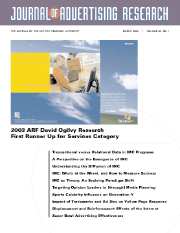EDITORIAL
Editorial: IMC's Fuzzy Picture: Breakthrough or Breakdown?
-
- Published online by Cambridge University Press:
- 04 May 2004, pp. 1-2
-
- Article
-
- You have access
- HTML
- Export citation
Research Article
The Role of Transactional versus Relational Data in IMC Programs: Bringing Customer Data Together
-
- Published online by Cambridge University Press:
- 06 May 2004, pp. 3-18
-
- Article
- Export citation
The Emergence of IMC: A Theoretical Perspective
-
- Published online by Cambridge University Press:
- 06 May 2004, pp. 19-30
-
- Article
- Export citation
Understanding the Diffusion of Integrated Marketing Communications
-
- Published online by Cambridge University Press:
- 06 May 2004, pp. 31-45
-
- Article
- Export citation
Perceptions of IMC after a Decade of Development: Who's at the Wheel, and How Can We Measure Success?
-
- Published online by Cambridge University Press:
- 12 May 2004, pp. 46-65
-
- Article
- Export citation
IMC as Theory and as a Poststructural Set of Practices and Discourses: A Continuously Evolving Paradigm Shift
-
- Published online by Cambridge University Press:
- 07 May 2004, pp. 66-70
-
- Article
- Export citation
Better Practices in Advertising Can Change a Cost of Doing Business to Wise Investments in the Business
-
- Published online by Cambridge University Press:
- 07 May 2004, pp. 71-89
-
- Article
- Export citation
Targeting Women's Clothing Fashion Opinion Leaders in Media Planning: An Application for Magazines
-
- Published online by Cambridge University Press:
- 12 May 2004, pp. 90-107
-
- Article
- Export citation
Sports Celebrity Influence on the Behavioral Intentions of Generation Y
-
- Published online by Cambridge University Press:
- 12 May 2004, pp. 108-118
-
- Article
- Export citation
The Impact of Trademarks and Advertisement Size on Yellow Page Call Rates
-
- Published online by Cambridge University Press:
- 10 May 2004, pp. 119-125
-
- Article
- Export citation
Displacement and Reinforcement Effects of the Internet and Other Media as Sources of Advertising Information
-
- Published online by Cambridge University Press:
- 12 May 2004, pp. 126-142
-
- Article
- Export citation
Super Bowl Advertising Effectiveness: Hollywood Finds the Games Golden
-
- Published online by Cambridge University Press:
- 10 May 2004, pp. 143-159
-
- Article
- Export citation
MANAGEMENT SLANT
Management Slant
-
- Published online by Cambridge University Press:
- 10 May 2004, pp. 160-162
-
- Article
- Export citation

